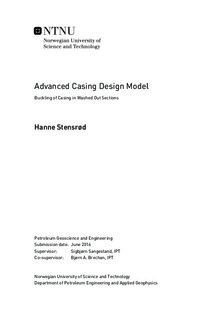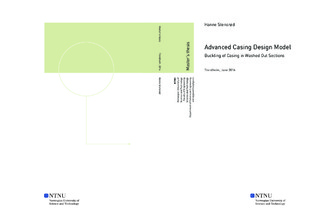| dc.description.abstract | Casing design for a well is based on an investigation of all possible loads the well can experience during its lifetime. A thesis model has been made in Excel based on the equations and assumptions given in literature; these are the same calculations the industry leading software (ILS) is supposedly based on. The well inputs in the thesis model and the ILS are the same, and several load cases are calculated in both models. However, not all the equations and assumptions in the ILS are known, which may be the reason why some of the results from the ILS are different from the thesis model results.
The results from the thesis model are compared to the output from the ILS, and not all the aspects of the models are the same. The differential pressures, axial loads, and the axial, collapse and burst safety factors are the same in both models, or so close that the difference is insignificant. However, the force due to buckling of the casing is stronger and occurs earlier in the ILS than in the thesis model, and the triaxial safety factor is almost always more pessimistic in the ILS. These issues are investigated further in this study.
The main focus of this study is some issues that are not addressed in the ILS. Among these are excessive hole enlargement (i.e. washout), poor cement job and misalignment of the casing. A washout may be a significant issue in some formations, and is therefore interesting to examine. As the washout increases the clearance between the casing and the formation, it may lead to significant buckling of the casing. If the cement job is a failure, i.e. little or no cement in the annulus, it is interesting to see how the axial load will behave and whether it has an impact on the casing design. This study also examines what happens if the cement job is a failure and a washout occurs. The last issue, misalignment of casing, checks what will happen if the casing is not in the middle of the hole as the ILS assumes, when the borehole is washed out.
These issues are investigated in comparison to the different axial loads, and the axial and triaxial safety factors as these aspects are directly affected by buckling of the casing. From these comparisons it is considered whether the issues will affect the casing design and should be implemented in the ILS. This study shows that the worst scenario is when the casing is misaligned and a washout occurs. In that case, the washout does not need to be large in comparison to the other cases to be significant in relation to the casing design. | |

